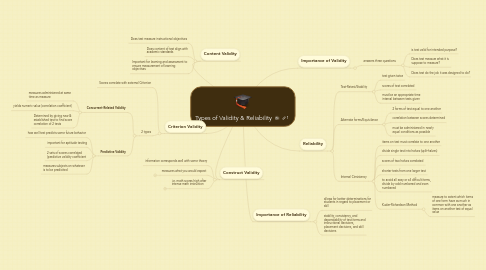
1. Content Validity
1.1. Does test measure instructional objectives
1.2. Does content of test align with academic standards
1.3. Important for learning and assessment to ensure measurement of learning objectives
2. Criterion Validity
2.1. Scores correlate with external Criterion
2.2. 2 types
2.2.1. Concurrent-Related Validity
2.2.1.1. measures administered at same time as measure
2.2.1.2. yields numeric value (correlation coefficient)
2.2.1.3. Deternined by giving new & established test to find score correlation of 2 tests
2.2.2. Predictive Validity
2.2.2.1. how well test predicts some future behavior
2.2.2.2. important for aptitude testing
2.2.2.3. 2 sets of scores correlated (predictive validity coefficient
2.2.2.4. measures subjects on whatever is to be predicited
3. Construct Validity
3.1. informaton corresponds well with some thoery
3.2. measures what you would expect
3.2.1. Task
3.2.2. Prerequisites
3.3. i.e. math scores high after intense math instruction
3.3.1. Task
3.3.2. Prerequisites
4. Importance of Validity
4.1. answers three questions
4.1.1. is test valid for intended purpose?
4.1.2. Does test measure what it is suppose to measure?
4.1.3. Does test do the job it was designed to do?
5. Reliability
5.1. Test-Retest/Stability
5.1.1. test given twice
5.1.2. scores of test correlated
5.1.3. must be an appropriate time interval between tests given
5.2. Alternate forms/Equivilance
5.2.1. 2 forms of test equal to one another
5.2.2. correlation between scores determined
5.2.3. must be administered in nearly equal conditions as possible
5.3. Internal Cinsistency
5.3.1. items on test must correlate to one another
5.3.2. divide single test into halves (split-halves)
5.3.3. scores of two halves correlated
5.3.4. shorter tests from one larger test
5.3.5. to avoid all easy or all difficult items, divide by odd numbered and even numbered
5.3.6. Kuder-Richardson Method
5.3.6.1. measure to extent which items of one form have as much in common with one another as items on another test of equal value
